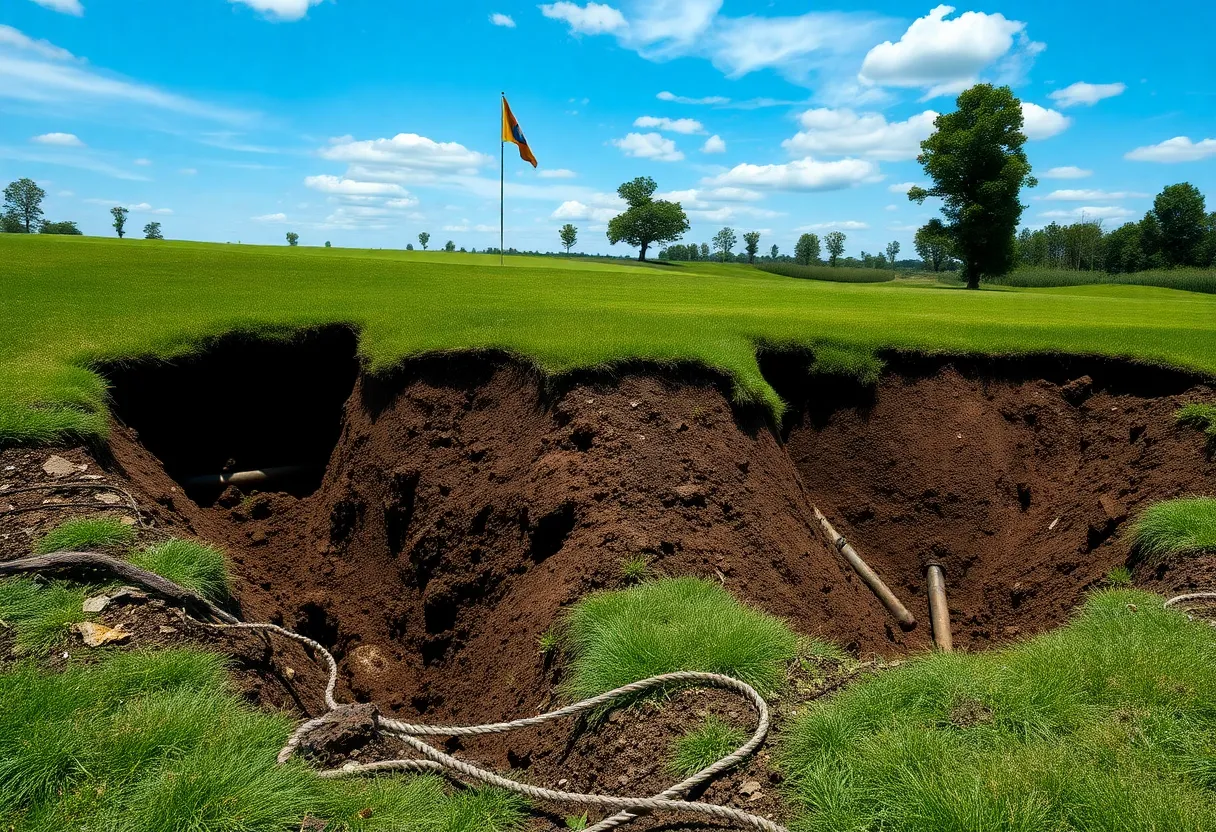News Summary
Concerns arise over old asbestos pipes at Kanawaki Golf Club, posing health risks. Urgent action needed for safe removal and environmental protection.
Urgent Action Required: Asbestos Threat at Kanawaki Golf Club
Concerns are swirling around the Kanawaki Golf Club as the presence of old asbestos pipes buried underground has come to light. These hazardous materials were discovered during routine excavation work for a new drainage system, raising alarms about potential health risks to workers and the surrounding community.
Underground Menace
The cement pipes, remnants of a long-defunct water irrigation system, date back to a time when asbestos was widely used in construction materials, particularly between the 1940s and 1960s. Asbestos is infamous for its health risks, particularly its connection to serious diseases like mesothelioma, resulting from inhaling airborne fibers. With the pipes now undergoing significant deterioration, officials stress the urgent need for their removal to prevent any potential leaching of asbestos into the soil and groundwater.
A Call for Collaboration
Management at Kanawaki Golf Club and Indigenous Services Canada (ISC) find themselves at a crossroads. They have yet to devise a comprehensive plan for the safe removal of these hazardous pipes. Recent meetings involving council chief David Diabo have emphasized the necessity for better planning to tackle this critical issue effectively. The involvement of the Kahnawake Environment Protection Office (KEPO) aims to ensure that the issue of asbestos is addressed with diligence and responsibility.
Environmental Oversight
For years, KEPO has diligently monitored the site, focusing on soil and groundwater samples. Thankfully, no evidence of asbestos contamination has surfaced so far. However, soil tests have uncovered traces of heavy metals at levels deemed not immediately dangerous to health or the environment. Yet the legal obligation to return the land to its original condition looms heavy, highly emphasizing the urgency to mitigate any possible risk.
Lease Agreement Extension
Interestingly, a renewed lease agreement between Kanawaki and the Canadian government notably extends through November 2046, allowing additional time to address the environmental concerns raised by the discovery of the asbestos pipes. While this extension may provide a temporary reprieve for management at the golf course, it also places them under scrutiny for failing to identify and manage this hazardous situation before it escalated.
Worker Safety and Health Concerns
A growing number of workers at the golf course have raised their voices, voicing serious health concerns about the alleged mishandling of hazardous waste. Reports indicate that segments of broken cement pipes were excavated, moved, and in some instances, reburied in various locations around the golf course—raising questions regarding proper disposal procedures. Workers were reportedly unaware of the hazardous nature of the materials until discussions with KEPO brought the issue to light.
Protocol for Hazardous Waste
In an effort to implement safe handling practices, KEPO has established strict protocols for dealing with asbestos materials. These include sealing contaminated materials in plastic bags and hiring specialized disposal companies to mitigate risk. However, management claims ignorance of the asbestos pipes until KEPO alerted them, while employees argue that previous management was fully aware of the risks and had operated under established guidelines for asbestos disposal.
Moving Forward
Currently, KEPO has issued a directive for all activities involving the asbestos pipes to be halted until they can further engage with federal officials to develop a corrective action plan. ISC has expressed a commitment to collaborate with golf course management, KEPO, and the band council to devise a viable strategy for addressing the critical situation by the end of the month.
The case of Kanawaki Golf Club serves as a concerning reminder of the lingering dangers posed by contaminated materials in public spaces. Urgent action is essential to ensure the safety of workers and protect the environment from the perils associated with asbestos. With more discussions on the horizon, stakeholders must prioritize safety and responsible management of hazardous materials to avoid further risks to health and the environment.
Deeper Dive: News & Info About This Topic
HERE Resources
Asbestos Violations Cause Alarm in Elkhart Company
The Minns Labor Government Unveils Lung Health Mobile Clinic to Combat Dust Diseases
Mesothelioma and Asbestos Exposure: The Alarming Reality in Louisiana
Virginia Faces Growing Challenges in Mesothelioma Cases Linked to Asbestos Exposure
Transformation of Mansfield Town Centre with Mansfield Connect Project
Family Seeks Justice After Builder’s Mesothelioma Death
Acorn Analytical Services Expands Workforce to Meet Demand
Serious Asbestos Errors by Social Housing Provider Raise Alarm
The Asbestos Crisis in UK Housing: Urgent Calls for Action
Concerns Emerge Over Asbestos Woes at Iconic Cheltenham Hotel
Additional Resources
- The Eastern Door: Asbestos Concerns at Kanawaki
- Wikipedia: Asbestos
- The Spec: Kahnawake Mohawk Council to Oversee Remediation
- Google Search: Asbestos Health Risks
- The Eastern Door: Asbestos Pipes Must be Removed
- Google Scholar: Asbestos Remediation
- Government of Canada: Contaminated Sites
- Encyclopedia Britannica: Asbestos
- Google News: Asbestos Removal



















